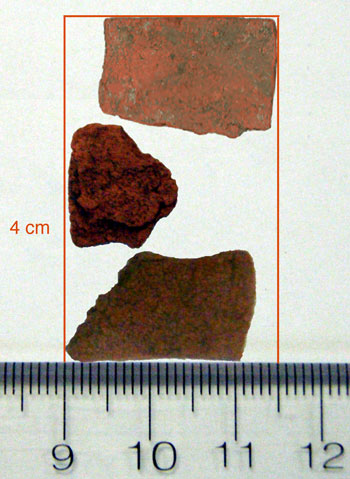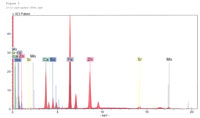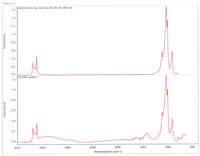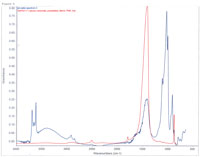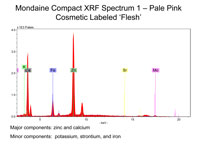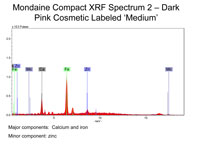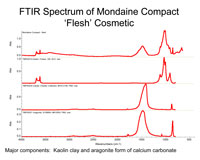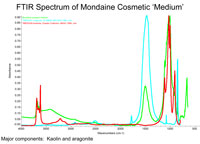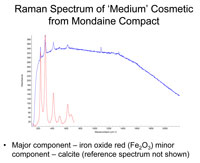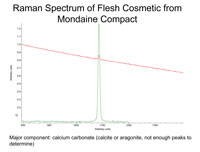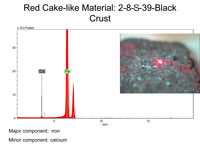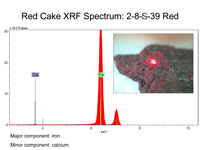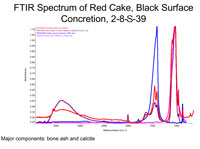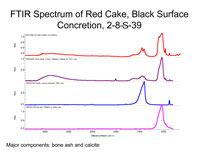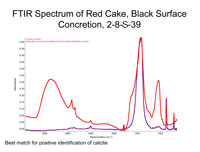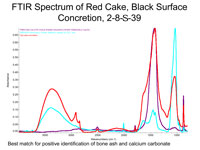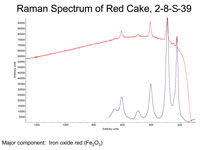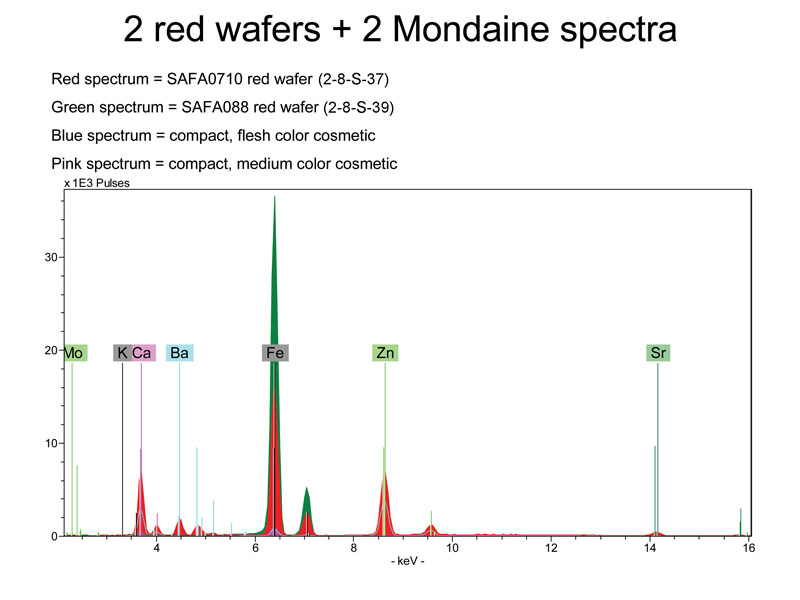 |



Red
Cake-Like Material |
|||
Report: Possible Cosmetics
These are the items discussed in this section:
The red wafer. |
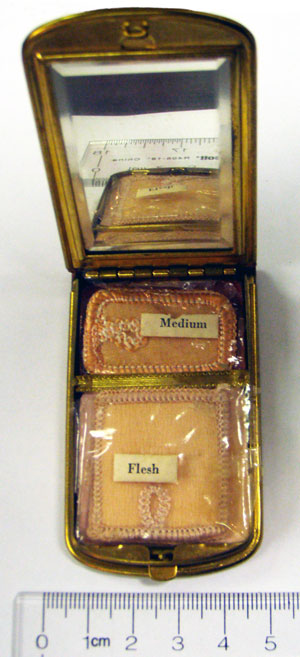 |
2-8-S-39 |
Mondaine compact purchased for comparison. |
|
|
| 2-8-S-39 & Mondaine Compact | |||||||||||||||||||||||||||
Artifact 2-8-S-39 was the subject of analysis in two stages. In the first step, it was analyzed for elemental makeup; in the second, it was looked at in comparison with the Mondaine compact purchased on eBay for that purpose. The Purdue University Library Special Collections has among its Earhart holdings a Mondaine compact which belonged to her and was donated with other effects to the Library by George Putnam. The small compact we purchased was new and unused; the cellophane protecting the makeup was still intact (see photo above). It dates from the 1930s. From Report 71:
(Click on the thumbnails above to open full-sized images in a new window.) From Report 88:
Results and Conclusions
|
| Interpretation: |
WHAT This chart is an overlay of four different charts: Figures 1, 4, 5, and 11, above, corrected to the same scale by Dr. Mass. The red in the chart is from artifact 2-8-S-37, a chunk of red cake-like material. The green is from 2-8-S-39, another chunk of red cake-like material. The blue is from the lighter cosmetic in the Mondaine compact purchased for comparison, and the pink is from the darker cosmetic from the Mondaine compact. There is a strong correspondence in the peaks which leads us to conclude that the red wafers are the remnants of cosmetic. WHERE The chunks of red cake-like material were found at the Seven Site, a part of Nikumaroro which is remote from the village and the main traffic of life on the island. There was an attempt to plant coconuts in the area; we believe that this planting was the source of the water tank which first led us to the site. In the spring of 1940 a human skull was found by a work party. Gerald Gallagher, Officer-In-Charge, later learned of the discovery and conducted a search, during which he found the partial skeleton of a castaway. WHO I-Kiribati women did not use cosmetics in the 1930s, and certainly not in colors related to European skin tones. During the Colonial period, very few European women visited Nikumaroro, and none is known to have visited the Seven Site. The Coast Guard personnel did visit the site, but none has reported any use of makeup or other material which might mimic makeup. This leaves the castaway. |
Object Descriptions and Reason for Analysis • OBJECT DESCRIPTIONS (form, material, color, etc): The objects submitted for analysis are archaeological material excavated from the Republic of Kiribati and reference material related to the Kiribati artifacts. They include: artifact 2-8-S-37, a red wafer; artifact 2-8-S-39 (a dark red flat cake with a black crust), and a Mondaine cosmetic case containing two items, a dark pink rouge labeled ‘Medium’ and a very pale pink pressed foundation powder labeled ‘flesh’. • REASON FOR ANALYSIS: Could these objects have an early twentieth-century American provenance? Could they have been manufactured prior to 7/2/37? Specific questions include: Is the composition of the red concretion consistent with that of a cosmetic? If so, is its composition consistent with an early twentieth-century provenance? What is the composition of the two cosmetics in the Mondaine compact? How do they relate to the composition of the red cake-like material found on the Kiribati site? • SAMPLING: Microgram sized samples were removed from the ‘medium’ and ‘flesh’ powders in the compact for FTIR and Raman analysis using a #11 steel scalpel blade. Samples were removed from the black concretion on the red cake for FTIR analysis also using a size 11 steel scalpel blade. All samples for chemical analysis were transferred to glass containers to prevent contamination prior to analysis. All other analyses were performed nondestructively. • ANALYSIS PROTOCOL: X-ray fluorescence analysis was used to identify the elemental compositions of the red cakes and the Mondaine compact contents. Fourier transform infrared spectroscopy (FTIR) was used to identify the molecular composition of the Mondaine compact contents and the black crust on the red cake. Raman spectroscopy was used to identify the molecular composition of the Mondaine compact contents and the red cakes. |
Click HERE for a PDF of Report
71. (2.1 MB)
Click HERE for a PDF of Report 88. (2.2 MB)
Click HERE to see a photo gallery from Niku V.
Your continued support is vital. Artifact analysis and research is already well begun and we need to do much more. To donate to the Earhart Project click here.
To join the expedition’s growing family of corporate sponsors please contact TIGHAR executive director Ric Gillespie by email or by phone at (610) 467-1937.
photekimaging.com |
digitalglobe.com |
markertek.com |
thursby.com |
sibfla.com |
journeysaviation.com |
 lehightesting.com |
|
 whiteselectronics.com |
TIGHAR is a 501(c)(3) public charity. All contributions are tax deductible to the full extent of the law.
 |
Copyright 2021 by TIGHAR, a non-profit foundation. No portion of the TIGHAR Website may be reproduced by xerographic, photographic, digital or any other means for any purpose. No portion of the TIGHAR Website may be stored in a retrieval system, copied, transmitted or transferred in any form or by any means, whether electronic, mechanical, digital, photographic, magnetic or otherwise, for any purpose without the express, written permission of TIGHAR. All rights reserved. Contact us at: info@tighar.org • Phone: 610.467.1937 • JOIN NOW |
